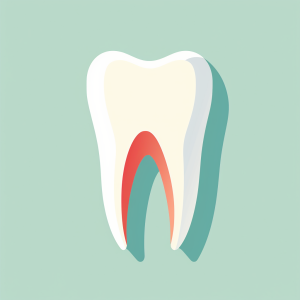8 mm Periodontal Pockets: Risks and Effective Treatment Strategies
Last updated Wednesday, December 13th, 2023

Did you know that something as seemingly innocuous as a tiny space around your teeth can have a significant impact on your overall health? Yes, we’re talking about periodontal pockets, and understanding these pockets is crucial for maintaining a healthy, radiant smile. In this blog post, we’ll delve into the complex world of 8 mm periodontal pockets, discussing their causes, consequences, diagnosis, treatment options, prevention strategies, and the role of dental professionals.
Understanding 8 mm Periodontal Pockets
Healthy gums typically have periodontal pockets that are 3 mm or less in depth. Conversely, gum pockets that are 4 mm or deeper signify unhealthy conditions. Gum disease contributes to the formation of these deeper pockets, causing significant damage. Untreated gum disease can progress from mild gingivitis to advanced periodontitis, causing destruction of the tissues surrounding the teeth, such as bone, periodontal ligaments, and gum tissues.
Moderate periodontal disease is indicated by a gap of 5 to 7 mm, while severe cases involve periodontal pockets of 8 mm or deeper. If bacteria in a periodontal pocket remain undisturbed, further loss of bone and gum tissue attachment beneath the gum line can be expected, leading to erosion of the structures that support the teeth.
Ready to Get Your Beautiful Smile?
CALL (480) 780-1511
Take control of your life and give yourself the smile you deserve! With our New Patient Special, the time to book your appointment for your laser periodontal treatment is now!
Causes of Deep Periodontal Pockets
The presence of periodontal pockets indicates gum disease and bone loss. Plaque buildup, tartar, and inflammation can lead to gum tissue and bone destruction, resulting in deep periodontal pockets. Plaque is a sticky film that accumulates on the teeth and contains bacteria. If not removed through regular brushing and flossing, it can harden into tartar, which further irritates the gums.
The bacteria in plaque and tartar secrete toxins that cause inflammation and damage to the gum tissue. Over time, this inflammation can lead to the formation of deep pockets between the gums and teeth, allowing bacteria to accumulate and further damage the supporting structures of the teeth. Tartar also plays a role in the formation of 8 mm periodontal pockets by acting as a surface for bacteria to attach to, causing inflammation and swelling of the gums, and deepening the pocket between the gum and the tooth.
Consequences of Untreated Deep Pockets
 Failing to treat deep pockets may lead to tooth loss, bone loss, and a heightened risk of other health complications. There is a strong association between deep periodontal pockets and tooth loss, as untreated inflammation and infection can cause destruction of the supporting structures of the teeth, including the gums, bone, and ligaments, ultimately leading to tooth loss. Prompt attention to deep periodontal pockets is necessary to prevent further damage and uphold oral health.
Failing to treat deep pockets may lead to tooth loss, bone loss, and a heightened risk of other health complications. There is a strong association between deep periodontal pockets and tooth loss, as untreated inflammation and infection can cause destruction of the supporting structures of the teeth, including the gums, bone, and ligaments, ultimately leading to tooth loss. Prompt attention to deep periodontal pockets is necessary to prevent further damage and uphold oral health.
Untreated mild gum disease may also lead to increased risk of other health issues. As gum disease progresses, if periodontal pockets are not addressed, there is a risk of tooth loss, heart disease, stroke, diabetes, respiratory infections, and pregnancy complications. Treating gum disease in its early stages can help prevent these potential health risks.
Treatment of deep periodontal pockets not only safeguards oral health but may also potentially mitigate these other health risks.
Diagnosing Deep Periodontal Pockets
Deep periodontal pockets are typically diagnosed through the use of a periodontal probe during regular dental checkups. A periodontal probe is used to measure the depth from the pocket’s surface to its base, assessing periodontal pocket depth and helping diagnose periodontal disease in its early stages. Early diagnosis and treatment of deep periodontal pockets is vital to prevent severe complications.
To ensure the early detection and treatment of deep periodontal pockets, it is essential to visit your dentist regularly for checkups and periodontal examinations. Consistent oral health monitoring and assessment of periodontal pocket depth by your dental professional enables early issue detection, prevents complications, and facilitates timely treatment.
Importance of Regular Dental Checkups
During regular dental checkups, dental professionals use a periodontal probe to measure the depth of the space between your gums and teeth, helping to diagnose gum disease. The numbers read off during an oral exam signify the presence of periodontal pockets and their depth. Regular dental checkups facilitate the timely diagnosis and management of deep periodontal pockets, enabling early intervention and treatment.
It is generally suggested to visit the dentist twice a year for dental checkups to detect periodontal pockets. Maintaining regular dental visits ensures early detection and treatment of developing periodontal pockets, thus preventing further complications and promoting oral health.
Signs and Symptoms to Watch For
Signs of deep periodontal pockets include bleeding, inflammation, and gum recession. Bleeding associated with deep periodontal pockets is caused by gum inflammation and infection, as well as the buildup of plaque and tartar, which irritate the gums and allow bacteria to accumulate in the pockets. Inflammation in deep periodontal pockets, characterized by gum redness, swelling, and bleeding, tends to intensify with the increasing pocket depth.
Gum recession is another symptom of deep periodontal pockets, as the gum tissue surrounding the teeth wears away or pulls back, exposing more of the tooth or the tooth’s root. As the gum tissue recedes, it creates larger spaces or pockets between the gums and teeth, facilitating plaque and tartar buildup, resulting in inflammation and further gum recession. The deep periodontal pockets can contribute to the progression of gum disease and the loss of bone around the teeth.
Treatment Options for 8 mm Periodontal Pockets
For individuals with 8 mm periodontal pockets, treatment options include non-surgical procedures such as scaling and root planing, as well as surgical interventions. Non-surgical treatments aim to remove bacteria, plaque, and tartar to shrink the periodontal pocket, while surgical treatments may be necessary for severe cases with significant bone loss.
Remember, the effectiveness of a treatment plan for deep periodontal pockets is contingent on the condition’s severity and the individual’s needs. Hence, close collaboration with your dental professional is crucial to determine the most appropriate course of action.
Non-Surgical Treatments
Scaling and root planing is a non-surgical dental procedure that eliminates bacteria, plaque, and tartar from around teeth while smoothing each tooth’s root surface. This treatment aims to reduce inflammation, promote gum tissue regeneration, and shrink the periodontal pocket. After scaling and root planing, antibiotics or an antibiotic mouthwash may be prescribed to reduce the number of oral bacteria and prevent further infection.
Cleaning the area to eliminate bacteria, plaque, and tartar is an effective non-surgical treatment for 8 mm periodontal pockets. Non-surgical treatments that tackle the problem’s root cause can halt further damage and maintain optimal oral health.
Surgical Treatments
In more advanced cases, surgical intervention may be necessary to reverse the damage caused by deep periodontal pockets. Surgical treatments for deep periodontal pockets include pocket reduction surgery, which involves the removal of excess tissue and reshaping of the bone to restore natural contours. This surgery aims to access the roots and eliminate the pockets for effective treatment.
A specialist, such as a periodontist, is typically the professional who performs pocket reduction surgery. Engaging a periodontist ensures an effective treatment plan for deep periodontal pockets, bringing the necessary expertise for optimal results.
Prevention Strategies for Deep Periodontal Pockets
Preventing deep periodontal pockets involves maintaining good oral hygiene and adopting a healthy lifestyle. Regular brushing, flossing, and dental checkups eliminate plaque and bacteria from teeth and gums, minimizing the risk of tartar buildup, gum inflammation, and infection.
A healthy diet and lifestyle can also help reduce inflammation and support overall oral health, contributing to the prevention of deep periodontal pockets. Conscious daily habit choices can help you maintain oral health and thwart the formation of deep periodontal pockets.
Proper Oral Hygiene Practices
To prevent deep periodontal pockets, it is advised to brush your teeth twice daily and floss once daily. Using an electric toothbrush and a toothpaste with the American Dental Association Seal of Acceptance, such as Colgate Total, Oral-B Gum Protection, Crest Gum Detoxify, and Meridol, can help maintain healthy teeth and gums.
Incorporating mouthwash into your oral hygiene routine can also help eliminate harmful bacteria in the mouth, reduce plaque accumulation, and support gum health. Consistent good oral hygiene practices and regular dentist visits can effectively ward off the development of deep periodontal pockets, helping maintain a healthy smile.
Healthy Diet and Lifestyle Choices
A healthy diet rich in fresh fruits and vegetables, grass-fed dairy products, lean meats, nuts, beans, green leafy vegetables, and fish can provide essential nutrients to maintain healthy teeth and gums and strengthen tooth enamel. It is also advisable to abstain from acidic foods, such as black coffee, tea, citrus fruits, pickled vegetables, and sugary foods, which can aggravate gum disease and compromise gum health.
Smoking and alcohol consumption have been linked to several negative effects on periodontal health, such as an increased risk of periodontitis, tooth discoloration, and mouth cancer. A healthy lifestyle and conscious dietary choices can bolster oral health and lower the risk of deep periodontal pocket development.
The Role of Dental Professionals in Managing 8 mm Periodontal Pockets
Dental professionals play a crucial role in managing 8 mm periodontal pockets through early detection, treatment, and follow-up care. Early identification of periodontal pockets helps evade minor issues from escalating into severe ones, and regular follow-up appointments are vital for progress monitoring and optimal oral health maintenance.
Working with a periodontist, a dental specialist with advanced training in treating periodontal disease, can help ensure the most effective treatment plan for deep periodontal pockets. Collaboration with dental professionals and adherence to scheduled follow-up appointments enables successful management of 8 mm periodontal pockets and a healthy smile maintenance.
Working with a Periodontist
Periodontists possess specialized training in periodontics, providing them with the expertise necessary to perform surgical treatments, such as flap surgery or pocket reduction surgery, to treat deep periodontal pockets. Consulting a periodontist rather than a general dentist for deep periodontal pockets offers several benefits, including specialized treatment, advanced techniques, prevention of disease progression, and rebuilding of damaged tissues.
Establishing a relationship with a periodontist and following their recommended treatment plan can greatly improve the outcome of your periodontal treatment and help prevent future complications. Working with a periodontist ensures an effective treatment plan for deep periodontal pockets and helps achieve optimal oral health.
Importance of Follow-up Appointments
Regular follow-up appointments are essential for monitoring the outcome of periodontal treatment and the condition of your teeth and gums. Dental professionals use regular periodontal maintenance visits to closely monitor gum health over time, measuring the pockets surrounding the gum tissue to assess if they have decreased.
It is generally recommended to have periodontal maintenance visits every three to six months or every three months for periodontitis patients, as the typical frequency of follow-up appointments after periodontal treatment can vary. Maintaining regular follow-up appointments guarantees the long-term success of your periodontal treatment and the preservation of your oral health.
Can 8 mm pockets be reversed?
Pocket depths of 8mm or more may not be completely reversible, but if caught early and treated correctly, significant improvement is achievable. With proper treatment and periodontal maintenance, a pocket depth of 4-5mm is typically attainable.
How many mm is a periodontal pocket?
The pocket depth in a healthy mouth is usually between 1 and 3 millimeters (mm). If pockets are deeper than 4 mm, they may indicate periodontitis and require treatment.
How many mm of gum recession is normal?
A normal pocket depth between teeth and gums is usually 1 – 3 mm. Pocket depths above 4 mm may require intervention to reduce the risk of periodontal disease.
Is a 7mm gum pocket bad?
A 7mm gum pocket is indicative of advanced periodontitis and severe bone loss, with frequent pain and bleeding of the gums. This can result in abscesses on the gums that can flare up and go away. Therefore, a 7mm gum pocket is bad.
What is considered a healthy periodontal pocket depth?
For a healthy periodontal pocket, it is generally recommended to measure 3mm or less for optimal gum health.
Get Started On Your New Smile
It's time you stop putting off your next dental visit. Whether it's a general check-up or a complex restorative or cosmetic procedure, the time to book your appointment is now!

